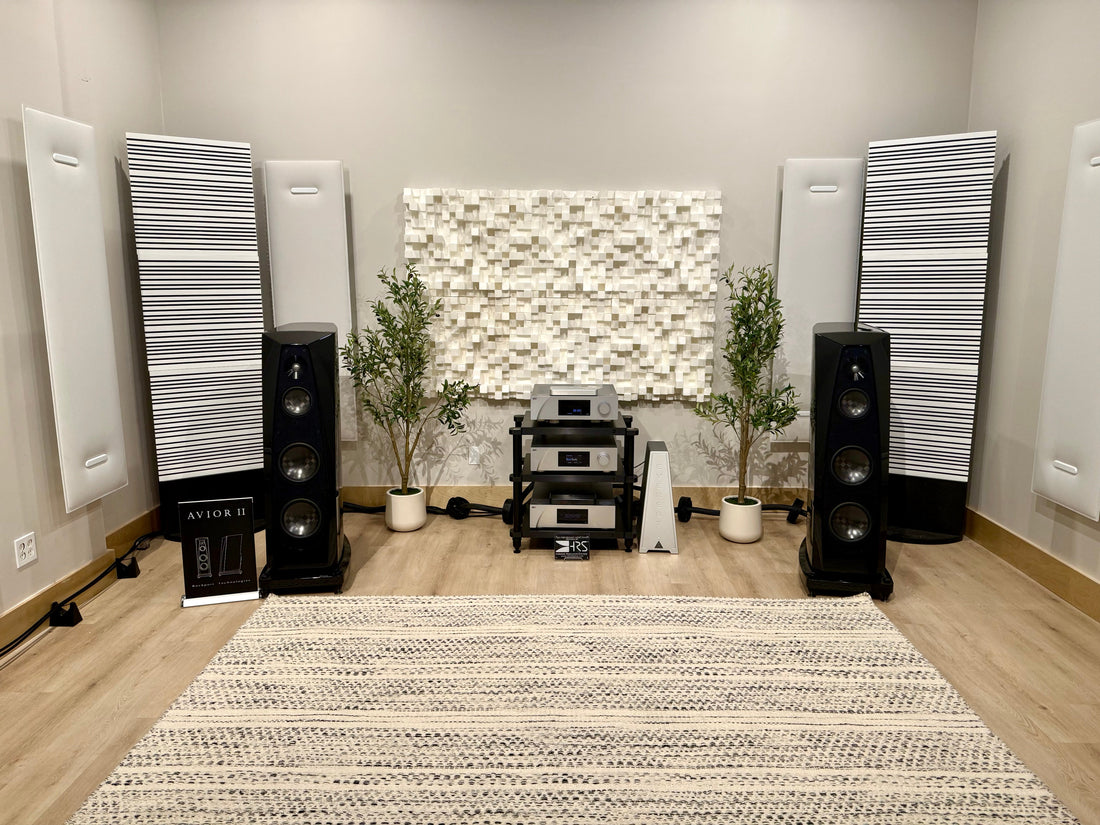
Power Sensitivity and synergy. Rockport and CH Precision's I1 Integrated Amplifier.
Share
Power, Sensitivity, and Synergy: Why Wattage Numbers Don’t Tell the Whole Story
One of the most misunderstood subjects in high-end audio is the relationship between loudspeaker sensitivity and amplifier power. Many assume that a “bigger watt number” means better control, more dynamics, and greater compatibility with speakers. In practice, the truth is far more nuanced — and infinitely more musical.
Let’s take two loudspeakers that are very dear to us, both from Rockport Technologies:
-
Atria II – rated at 87.5 dB SPL / 2.83V / 1m
-
Avior II – rated at 89.5 dB SPL / 2.83V / 1m
At first glance, one might assume that the Avior II, being 2 dB more sensitive, is “easier” to drive and therefore will automatically sound better with less power. But sensitivity ratings are not the whole picture.
What “dB SPL / 2.83V / 1m” Really Means
When we see 87.5 dB SPL / 2.83V, this specification tells us that if you apply 2.83 volts (equivalent to 1 watt into 8 ohms) and measure the speaker’s output at 1 meter, you will get 87.5 dB of sound pressure. A 2 dB difference (like between the Atria II and Avior II) is real but modest — it means the Avior II will play slightly louder with the same input voltage.
But here’s the hidden layer: impedance curves, phase angles, and how the speaker’s crossover loads the amplifier are just as important. A “90 dB” loudspeaker with difficult impedance swings can be more challenging to drive than an “87 dB” loudspeaker with a more amplifier-friendly load.
Wattage vs. Current Delivery
This is where amplifiers separate themselves. The CH Precision i1 Integrated Amplifier, rated at a true 100 watts per channel, consistently drives both Rockport models with absolute command. The bass is taut and extended, transients leap from the darkness of silence, and decays linger naturally.
By contrast, we’ve heard these same Rockports paired with a 200 WPC integrated amplifier from another manufacturer. On paper, twice the power. In reality, the presentation was leaner, thinner, and emotionally disconnected.
Why? Because music reproduction is about current delivery, stability into complex loads, and circuit design — not just published wattage. The CH’s 100 watts are honest, conservatively rated, and backed by an architecture designed to deliver instantaneous current and remain linear under load.
The Rockport Lesson: Passion and Precision
I was fortunate enough to witness firsthand the passionate engineering that defines Rockport Technologies. The team operates with a strict, almost sacred manual — a step-by-step process that balances hard measurement with the art of listening.
Every Rockport loudspeaker begins with rigorous engineering principles refined over decades. But when it comes to the crossover design, the process shifts into something unique: each loudspeaker pair is tuned individually. The drivers are not treated as “parts” but as living components that must be matched together in their final cabinet.
The engineers spend up to two full days fine-tuning, measuring, and—most importantly—listening. Each pair undergoes three independent listening sessions by different team members, and only when all three sign off does the loudspeaker receive its serial number and identity.
This obsessive dedication means no two Rockports are ever “just another unit.” Every pair carries its own voice, identity, and soul — and this explains why they consistently tug at the heart as much as they satisfy the mind.
The Role of Synergy
When we’ve paired these same Rockports with ASR Audio’s Emitter II (two-chassis design with external power supply), the results were equally magical, but in a different way. The immense power reserves and ultra-low noise floor created a canvas where the Rockports could breathe dynamically, yet retain their inherent warmth and fullness.
This is what separates true high-end matching from spec-sheet comparison:
-
Design philosophy – topology, parts quality, and biasing matter more than the wattage rating.
-
Current capability – the ability to source and sink real current into complex speaker loads.
-
Synergy – the right amplifier doesn’t just “power” a loudspeaker, it complements its voicing and reveals its soul.
Takeaway
The Rockport Atria II (87.5 dB) and Avior II (89.5 dB) are not “hard” speakers to drive when paired with the right electronics. Numbers on a spec sheet can mislead; what matters most is how the amplifier interfaces electrically and musically with the speaker.
CH Precision I1 Integrated Amplifier
The CH Precision I1 is far more than a simple integrated amplifier — it is a complete system in one elegant chassis. Rated at a true 100 watts per channel into 8 ohms, the I1 delivers power with astonishing control, speed, and musical refinement. Unlike many amplifiers that simply list wattage, the I1 backs its rating with massive current reserves and circuit topology derived directly from CH’s reference separates.
What sets the I1 apart is its modular architecture. Owners can tailor the unit with optional cards, including a streaming board, phono stage, USB input, or even a digital-to-analog converter — making it one of the most flexible reference integrated amplifiers available.
In listening, the I1 is a study in contrasts: bass is taut and authoritative, transients leap from a velvety black background, and decays unfold with unforced naturalness. It embodies the CH Precision ethos of neutrality with soul — never imposing its own character, yet always revealing the essence of the music.
For many, the I1 is not just an entry into the world of CH Precision — it is a destination
The CH Precision i1’s 100 watts demonstrate that quality watts with high current delivery outperform “bigger” but less stable amplifiers. And the Rockport engineering process reminds us that a loudspeaker is more than the sum of its drivers and crossover — it is a handcrafted identity, born of both science and soul.
That is why, when these components come together with care and passion, the result is more than sound. It is music in its purest form.
